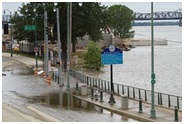Floodwaters

You can find yourself in dangerously deep water for a number of reasons. A brief loss of control of your vehicle may have you driving off the road and into a pond or river. Maybe you made the poor decision to drive through a flooded street, unaware of just how deep the water is. In the worst case scenario, your vehicle gets picked up and carried away in a strong current.
If you find yourself in deep water and need to vacate your vehicle, use a WINDOW. If you open a door, you will let more water in more quickly. If your vehicle is fully submerged, plan to work your way to the back. The heavier front side of your vehicle – the engine side – will sink first. Any available air will be at the back. Plan to make an escape through a window after the vehicle settles. You may have to take a deep breath and swim from the vehicle to the surface of the water.

If you are stuck in floodwater and your vehicle gets picked up by a rushing current, you can try to ride things out until the vehicle hits solid ground and holds steady. If a current pulls you into deep water where the vehicle becomes submerged, you’ll have to resort to the tactics you read about earlier.
One of the best ways to avoid getting yourself into this dangerous situation is not to drive in any deep water. If you absolutely must pass through, don’t go at the same time as any other vehicle. The wake created by that other vehicle could cause your engine to stall out. Drive slowly. Before you go, check the depth of the water by seeing how far up it is on street signs, other vehicles, or any other objects in the area.
Also remember that deep water, even just deep puddles can be dangerous. Deep water hides potholes or other hazards in the road. Deep water also causes brake failure. If you drive through deep puddles, test your brakes immediately after to be sure they work. To dry wet brakes, lightly press on the brake pedal and gas at the same time. Then, immediately test the brakes to be sure they are working properly.
